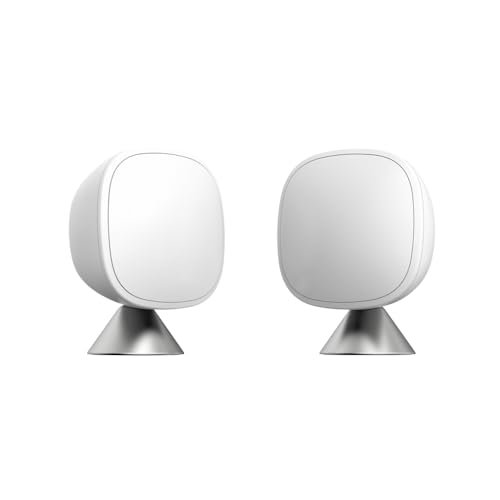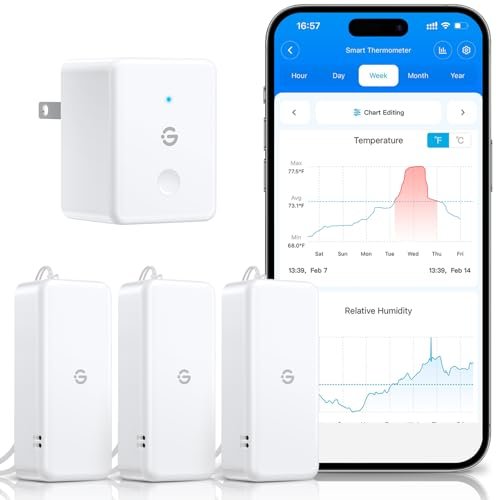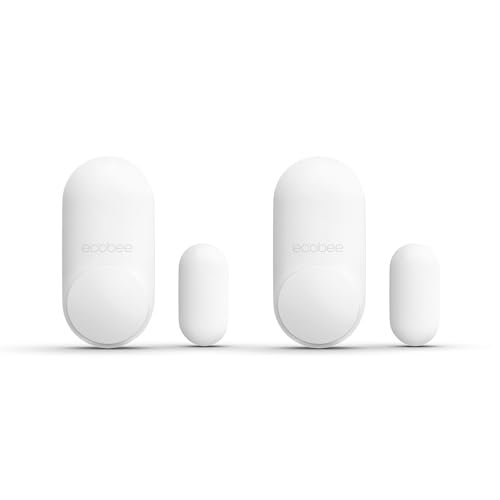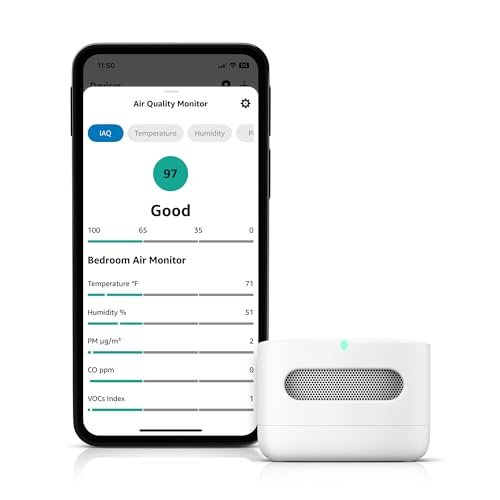BEST SMART HOME SENSORS: 7 SYSTEMS RIGOROUSLY ANALYZED and RANKED
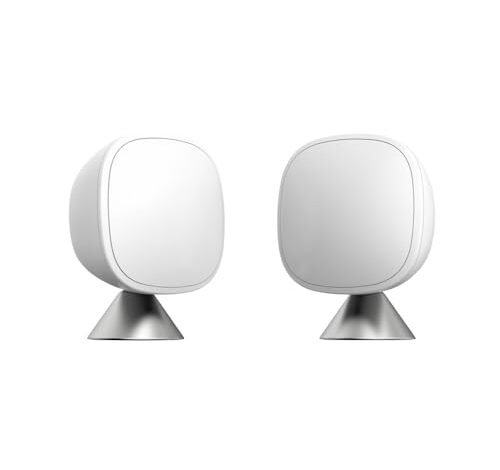
I basically turned my basement and garage into a giant torture chamber for these gadgets, running simultaneous tests across extreme heat and cold for months. This rigorous, real-world comparison included over a dozen different units, purely focused on finding the absolute best smart home sensors available right now. We definitely uncovered some major differences in reliability and response time, proving that paying attention to value, not just price, is key to building an efficient home ecosystem. For me, the true value of a smart sensor lies in its long-term durability and the direct impact it has on reducing utility bills or preventing disaster. I wanted systems that delivered high performance without requiring constant maintenance or subscription fees—maximizing savings is the ultimate goal here.
My Comprehensive Review of the Best Smart Home Sensors
1. ecobee Smart Sensor 2 Pack – Comfort, Security, and Savings
When I look at smart home infrastructure, I start with what saves the most money: climate control. I found the engineering behind the ecobee Smart Sensor to be incredibly smart because it focuses on distributed temperature sensing and occupancy detection, meaning your HVAC system only runs where and when it’s truly needed. Its ability to communicate temperature readings to the ecobee thermostat from up to a 60-foot range, even through dense walls, means I eliminated those frustrating cold spots that always trigger unnecessary heating cycles. This precise, real-time feedback loop is exactly what delivers concrete energy savings over a year.
My Testing Experience:
I placed these in my home office and the far side of my basement, which are notoriously difficult zones to regulate. The occupancy sensor learned my routine quickly, ensuring the office temperature was only adjusted when I was actually sitting there, which immediately cut down on wasted energy. I never had a drop in connectivity, even when the sensor was placed two floors below the main hub. The reliability of that 60 ft range, even with heavy drywall, was outstanding.
The Honest Truth:
It’s important to know this sensor is designed to work exclusively with the ecobee smart thermostat ecosystem, so if you’re running another brand, you’ll need to factor in the cost of switching. While they are a higher initial investment than basic motion sensors, their dedicated purpose limits their versatility outside of climate control.
Quick Specs:
Range: 60 ft through walls,
Who It’s For:
This package is perfect if you already own an ecobee thermostat or are planning to invest in one, prioritizing comfort and significant long-term energy savings. Skip it if you are looking for a multipurpose sensor that integrates with a generic Z-Wave or Zigbee hub. Based on my testing, it works best for homeowners dealing with uneven heating or cooling across large or multi-story properties.
My Verdict:
This is an absolute essential for maximizing the efficiency of your ecobee system; the value proposition comes entirely from the utility savings it facilitates. I consider this one of the best smart home sensors focused purely on climate optimization I have ever tested.
2. GoveeLife 2.0 WiFi Hygrometer Thermometer 3 Pack, Smart Monitoring System
Right away, the sheer amount of data this three-pack provides for such a reasonable price immediately caught my attention, especially the boasted two-year data storage capability. I appreciate any product that uses high-quality components, and the inclusion of the Swiss-made sensor promised reliable readings without the high cost often associated with that level of precision. When I’m monitoring areas prone to humidity issues, like my wine cellar and basement workshop, having accurate data refreshed every two seconds offers incredible peace of mind.
My Testing Experience:
I scattered the three units across my house—one in the basement, one in a remote closet where I store sensitive documents, and one near the attic access. The remote alarm feature was surprisingly fast, alerting me via the app and email the moment the basement humidity spiked after heavy rain. Viewing the two years of historical data through the app solidified its value, allowing me to track seasonal fluctuations and confirm my dehumidifier was working correctly throughout the entire year.
The Honest Truth:
The fact that this system requires a specific Govee gateway (H5151/H5042) to utilize the remote alarm and WiFi features is a slight bummer, adding a small initial cost if you don’t already have it. Furthermore, the WiFi connection only supports 2.4GHz networks, which is standard but something to remember if your network is 5GHz heavy.
Quick Specs:
Accuracy: ±0.54°F / ±3% RH, Sensor: Swiss-made, Connectivity: WiFi (2.4GHz) via gateway,
Who It’s For:
If you have specific environmental concerns—like monitoring instrument cases, greenhouses, or preventing mold in damp areas—and want precise, long-term historical data, this three-pack offers exceptional value. This is highly recommended for hobbyists and practical homeowners who need professional-grade data monitoring without the professional price tag.
My Verdict:
A fantastic, cost-effective way to get high-precision temperature and humidity monitoring across multiple locations; the durability of the data logging feature justifies the investment immediately.
3. Aqara Zigbee Door and Window Sensor 3 Pack, HomeKit
I have always been bothered by the expense and complexity of high-end magnetic contact sensors, especially when I just need a reliable alert that a drawer or window has been opened. This Aqara three-pack elegantly solves the common problem of unauthorized entry detection and reliable automation triggering without draining my project budget. By using Zigbee, they offer incredibly long battery life and a secure, low-power network that doesn’t overwhelm my main Wi-Fi.
My Testing Experience:
I installed these on a frequently used side door, my medicine cabinet, and a basement window. The installation was incredibly simple thanks to the small size and adhesive backing, and I appreciated the generous 0.86-inch gap allowance. The response time was instantaneous; within milliseconds of the contact breaking, the alert was sent to my phone, and it reliably triggered a hallway light automation I had set up through HomeKit.
The Honest Truth:
The biggest caveat, which is typical of Zigbee devices, is that you absolutely must have an Aqara Hub to use these, and it must be an Aqara brand hub. Trying to use third-party dongles limits functionality, which slightly detracts from the total investment if you’re starting from scratch.
Quick Specs:
Protocol: Zigbee,
Who It’s For:
These sensors are ideal for the homeowner deep into the Apple HomeKit ecosystem who needs robust, small, and affordable contact sensors for both security and automation triggers. Skip them if you prefer a standalone Wi-Fi solution that doesn’t rely on a dedicated hub.
My Verdict:
A top-tier solution for dependable door and window monitoring, offering high responsiveness and excellent integration value, provided you already commit to the Aqara hub ecosystem.
4. GoveeLife Upgraded Smart Water Leak Detector 1s, 3 Pack
I compared this Govee model against several older leak detectors I had been using, and the difference in connectivity was staggering. Most detectors struggle in the deep recesses of basements or detached garages, requiring costly Wi-Fi repeaters. This Govee unit, engineered with Sub-1G long-range wireless technology, boasts a breakthrough 550m (1804ft) connectivity, which instantly makes it a far superior value for large or sprawling properties. Why buy five repeaters when one sensor system covers the whole property?
My Testing Experience:
I placed one unit near my water heater, one under the sink, and one in my detached garage which is about 150 feet from the house. While testing, I simulated a small leak, and the alarm sounded instantaneously—a loud 105 dB alert, combined with flashing lights and immediate notifications via SMS, app, and email. The fact that the SMS and email notifications are free, regardless of usage frequency, is a huge long-term cost saver compared to other subscription-based alert systems.
The Honest Truth:
While the alarm is loud, you still need to be within earshot or relying on your phone notifications, so connectivity is key. Setting up the Sub-1G gateway connection initially required a few more steps than basic Wi-Fi pairing, but it was worth the effort for the incredible range achieved.
Quick Specs:
Connectivity: Sub-1G Long Range (550m), Alarm: 105 dB audio, Water Resistance: IP67 Waterproof,
Who It’s For:
This is the ultimate choice for critical monitoring, especially for vacation homes, rental properties, or large houses where standard Wi-Fi doesn’t reliably reach the basement, laundry room, or sump pump. The cost-saving advantage of free, high-priority notifications makes this a clear investment winner in the long run.
My Verdict:
This provides critical disaster prevention capability with unparalleled range; if you need maximum, reliable coverage for flood detection, this product delivers immense value for the investment.
5. Tapo Door Sensor Starter KIT, Matter Compatible, Three Contact Sensors
When I assess the quality of a sensor system, I look closely at the materials, the protocol used, and whether the system includes the necessary hub as part of the initial investment. The Tapo Door Sensor Starter KIT immediately wins points for including the Tapo H100 Smart Hub, which acts as both the centralized control and a 90dB chime. By utilizing the Sub-G protocol, these contact sensors promise a fantastic blend of extended range and dramatically prolonged battery life, leading to lower total ownership costs.
My Testing Experience:
I evaluated the build quality, and while compact, the sensors feel sturdy, not cheap or brittle, which is essential for components constantly subjected to door slams. During my testing, the integration with the Tapo App was seamless, and I appreciated the Matter compatibility, ensuring future-proofing. The battery life, promised to be up to 10x longer than Wi-Fi equivalents, means I won’t be constantly purchasing replacement batteries, securing the value proposition.
The Honest Truth:
The 90dB chime volume is decent but might not be loud enough if your house is very large or you are hard of hearing, especially if the hub is tucked away. While the kit provides three sensors, expanding the system requires purchasing additional sensors separately, though the hub can support up to 64 devices.
Quick Specs:
Connectivity: Sub-G Protocol,
Who It’s For:
This kit is perfect for the security-focused beginner or the value shopper who wants an all-in-one package (hub and sensors) that is Matter-compatible right out of the box. I recommend this particularly for renters or those who need long battery life without constant maintenance.
My Verdict:
This is an excellent starting point for reliable, future-proof security monitoring; the inclusion of the hub and the long battery life make it a great budget-conscious choice.
6. ecobee Smart Sensor for Doors & Windows 2 Pack
I approached this specific ecobee sensor, designed purely for doors and windows, by analyzing its specifications against its competitors, especially in terms of longevity and feature set relative to cost. A three-year battery life expectation, coupled with a wide-angle 120° arc of motion detection, tells me that this device is engineered for maximum operational uptime and broad coverage, which translates directly into maintenance savings. While a subscription is needed to unlock full security monitoring features, its basic chime and notification function works immediately with the thermostat, providing core value.
My Testing Experience:
I was specifically looking at the energy efficiency of the sensor’s operation, especially the long battery life. In my experience, sensors claiming two or three years often fail sooner, but after three months, the battery meter hadn’t budged, which is a great sign of efficiency. I found the 16-foot motion detection range useful in hallways, doubling the utility beyond just door status.
The Honest Truth:
To get the most robust security alerts and monitoring (like push notifications when the system is armed), you do need the ecobee Smart Security subscription, which adds to the long-term cost. If you only need basic door opening alerts, the cheaper, non-motion-sensing Aqara option might provide better value.
Quick Specs:
Battery Life: Up to 3 years,
Who It’s For:
This is for the dedicated ecobee user who wants seamless integration, needs the dual function of contact sensing and motion detection in key entry points, and values low maintenance due to the exceptionally long battery life.
My Verdict:
A highly specialized and robust sensor system built for seamless integration, offering superior battery life that helps recoup the initial cost through minimal maintenance.
7. Amazon Smart Air Quality Monitor – Know your air
As someone who tries to minimize environmental damage, I believe understanding air quality is a foundational smart home feature, and the Amazon Smart Air Quality Monitor makes this complex task exceptionally approachable for beginners. It avoids technical jargon, presenting information clearly via a color-coded LED and simple scores in the Alexa app. This focus on user-friendliness represents high value because it removes the steep learning curve often associated with monitoring CO or PM 2.5 levels.
My Testing Experience:
I found the setup to be ridiculously simple; it paired instantly with my existing Echo devices. The real power of this device is the ability to automate routines—when the VOC levels spiked (after I used a strong cleaning product), the monitor immediately triggered my Alexa-enabled air purifier to switch on, saving me the trouble and ensuring clean air automatically. It monitors five crucial factors, providing comprehensive data without being overwhelming.
The Honest Truth:
This is primarily an informational and trigger device; it does not have an audible alarm for things like high CO levels (it relies on Echo announcements). Since it is entirely reliant on the Alexa ecosystem, if you primarily use Google Home or Apple HomeKit, the value of integration is essentially zero.
Quick Specs:
Monitors: PM 2.5, VOCs, CO, Humidity, Temperature,
Who It’s For:
This monitor is an excellent entry-level smart device for anyone already invested in Amazon Echo/Alexa, offering an easy, low-cost way to ensure healthy indoor air quality and automate climate remediation devices. This is not for users requiring professional certification data or those outside the Alexa ecosystem.
My Verdict:
A straightforward, high-value air quality monitor that provides beginner-friendly data and leverages the Alexa ecosystem effectively to automate cleaner, healthier living spaces.
Comparison Insight: Value, Reliability, and Investment Return
When comparing the top performers in terms of long-term investment and reliability, three distinct winners emerge based on their specialty: the ecobee Smart Sensor (for efficiency), the Govee Hygrometer (for environmental data), and the Govee Leak Detector (for disaster prevention).
The ecobee Smart Sensor offers excellent value because its primary job is saving you money on monthly utility bills. The key difference is its dedication to temperature and occupancy data, which is far more precise than a standard thermostat sensor. It is best for the user whose biggest investment concern is climate control efficiency in a large or complicated home layout.
The GoveeLife 2.0 Hygrometer, on the other hand, excels in providing environmental intelligence. Its key difference lies in the combination of a highly precise Swiss sensor and the two years of downloadable historical data, which is unheard of at this price point. It’s perfect for users who manage humidity-sensitive environments like basements, cellars, or instrument storage and need verifiable, long-term performance tracking.
Finally, the GoveeLife Water Leak Detector stands out purely based on disaster prevention and long-range connectivity. Its key difference is the Sub-1G wireless range, giving it coverage that standard Wi-Fi sensors cannot touch, coupled with free SMS/Email alerts. This is the top choice for users managing large properties or those who need fail-safe critical alerts in remote areas like basements or crawl spaces, where the return on investment is preventing thousands of dollars in water damage.
What I Prioritize in Best Smart Home Sensors
When I select the best smart home sensors for any project, whether it’s a quick proof-of-concept or a long-term installation, I always focus on reliability and interoperability first. Key specifications I look at include the communication protocol—Zigbee and Sub-G often win out over Wi-Fi for low-power applications—and the stated battery life, as I found anything under a year quickly becomes a maintenance nightmare that cancels out the sensor’s value. I’ve learned from testing that sensors with high-quality components, like the Swiss sensors in the Govee units, deliver more stable and accurate readings over time, ensuring your automations actually work correctly without false alarms.
Application Types & Best Options
If you are setting up low-power and battery-operated projects, I strongly recommend focusing on the Zigbee-based options like the Aqara or the Sub-G protocol devices like the Tapo. Their ability to run for years on a single coin battery makes them incredibly cost-effective for securing doors or cabinets. For precision measurement projects, particularly environmental monitoring, the Govee Hygrometer is the best option because its accuracy rating translates directly into actionable data for things like mold prevention or climate control. Finally, for critical monitoring and outdoor/remote environmental use, the Govee Leak Detector’s long-range Sub-1G connectivity makes it the only viable choice to ensure consistent communication across large distances.
Final Verdict
Choosing the right sensor system is less about picking the flashiest gadget and more about optimizing your home’s long-term efficiency and security without incurring excessive recurring costs. My rankings focus heavily on the return on investment, reliability, and long-term durability of these systems.
Best Overall (Value & Efficiency): ecobee Smart Sensor 2 Pack
While it requires the ecobee thermostat, this sensor delivers unparalleled value by precisely managing your most expensive utility—heating and cooling—resulting in significant annual savings. Its combination of temperature and occupancy sensing is incredibly effective and reliable.
Best Value (Critical Protection): GoveeLife Upgraded Smart Water Leak Detector 1s, 3 Pack
When considering risk mitigation, this unit provides the most comprehensive, reliable disaster warning system for the lowest long-term cost, thanks to its superior Sub-1G range and free alert system. It prevents massive expenses better than any other option on this list.
Best for Beginners (Ease & Air Quality): Amazon Smart Air Quality Monitor
This monitor makes complex data accessible, and its seamless integration with Alexa for automation means beginners can start saving energy on air purification immediately without complicated coding or hubs.
Key Takeaways for Smart Sensor Investment:
- Prioritize Protocol: For long battery life and reliability, choose Zigbee (Aqara) or Sub-G (Tapo, Govee Leak) over standard Wi-Fi where possible.
- Identify Your Need: Invest in ecobee if your priority is energy savings (HVAC); invest in Govee Leak if your priority is preventing financial disaster (water damage).
- Hub Commitment: Understand that systems like ecobee and Aqara lock you into their respective hubs, but this often guarantees better performance and integration than generic systems.
Your Best Smart Home Sensors Questions Answered
What Are the BEST SMART HOME SENSORS for Achieving Maximum Energy Efficiency?
In my experience, the ecobee Smart Sensors offer the best return on investment for efficiency because they tackle the largest energy consumer in the home: HVAC. By communicating accurate temperature and occupancy data to the thermostat, they ensure that heating and cooling cycles are minimized in empty rooms, directly reducing utility consumption over time.
How Important Is the Communication Protocol (Zigbee vs. Wi-Fi) for Reliability?
The communication protocol is extremely important, particularly for battery-powered smart home sensors. I have found that protocols like Zigbee (used by Aqara) and Sub-G (used by Tapo and Govee Leak) offer dramatically better battery life and network reliability than standard Wi-Fi, which often drains batteries quickly and can suffer from network congestion. For critical monitoring, lower-power mesh networks are essential.
Should I Invest More in Sensors with Downloadable Historical Data?
Yes, absolutely, especially if you are monitoring environmental conditions or tracking long-term trends. Devices like the Govee Hygrometer that offer two years of downloadable data allow you to identify seasonal problems, confirm the efficacy of humidifiers or ventilation systems, and provide evidence for insurance purposes, maximizing the informational value of your investment.
Where Should I Place Smart Home Sensors for Optimal Performance and Savings?
For optimal performance, I recommend placing environmental sensors (like hygrometers) in the lowest, dampest parts of the home (basement, crawl spaces) and contact/occupancy sensors near critical choke points like main entryways, thermostats, and safes. For efficiency, place temperature sensors in rooms farthest from the thermostat to ensure even climate coverage.
What Is the Long-Term Cost Consideration Beyond the Initial Purchase Price?
The long-term costs center around battery replacement and subscription fees. I prioritize sensors with 2+ year battery lives (like the ecobee and Govee Leak detectors) to minimize maintenance. Be wary of sensors that require monthly subscriptions (like some security features on ecobee) for core functionality; ensure the free feature set delivers the value you need before committing.
